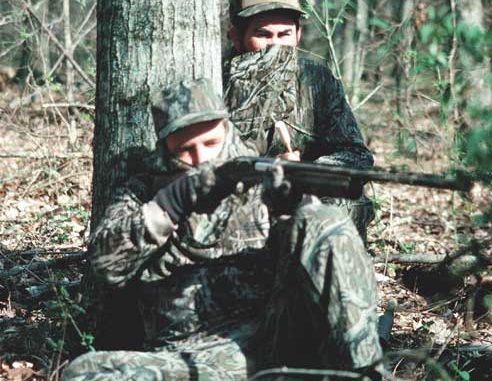
Late-season wild turkey hunting can be a successful experience with the use of special tactics and trickery.
Chasing late-season gobblers can be one of the sport’s greatest challenges. It also can be productive and rewarding, despite popular sentiment among many turkey hunters.
If a hunter has a good game plan and can be a little bit sneaky, gobbler opportunities during late April and early May can be extremely productive.
How should a hunter approach this problem? Just consider and adjust to changes in the physical nature of the turkey woods and the mating season, just as a bass angler would change his approach from fishing during the spring spawn to summer.
First, near the end of the turkey season, hunters should consider how the surroundings where turkeys live has altered in a month’s time:
• The physical appearance of the woods will change from being predominantly barren of deciduous leaves to full green foliage.
• The peak of turkey mating season will have come and gone and many hens will be sitting at nests.
• The weather will have warmed considerably, making it less attractive to many hunters to be in the woods.
• Fewer gobblers will be available because hunters already will have sent a lot of longbeards to that big food plot in the sky.
However, there are some positive factors as well:
• Since a majority of — but not all — hens will be sitting at nests and incubating eggs, a longbeard won’t have as many female birds respond to his gobbles.
• At most areas, considerably fewer hunters will be in the woods late in the season. In fact, at some places, with increased heat, more insects and lower expectations of success, the woods sometimes will be almost devoid of hunters.
These conditions can trigger a superb opportunity for die-hard gobbler chasers.
Scott Sanders, a veteran wild turkey hunter, has hunted birds for many years and throughout the entire season. And he’s learned late-season turkey hunting can be productive and full of responsive gobblers.
“Some of my best hunts have occurred late in the turkey season, even the last day,” he said. “A lot of hens are sitting on nests and are out of the equation for gobblers. This leaves fewer hens for the gobbler to breed and can help put odds in my favor.
“Usually, even though the peak of the breeding season is past, most gobblers are still primed and ready (to mate with hens). With fewer hens available, they sometimes begin to get more aggressive. In some cases, gobbling activity will improve.”
As a result, Sanders said during the last week or two of the season, hunting can be exceptionally good. But hunters should adjust their techniques to match how the woods and turkey behavior will have changed.
“There are some changes in hunting styles and patterns that hunters must employ to be successful,” he said.
“Most gobblers will have heard calls and been worked by hunters. Just because hens get a bit scarce, the gobblers don’t get stupid. However, by adjusting your techniques to cope with late-season gobblers and the changing physical situation in the woods, you can call in and harvest trophy longbeards at this late stage.”
One of the first things Sanders does is ensure his camouflage pattern matches the woods where he’ll hunt. By late season, the woods are in full bloom and green leaves are the predominate pattern. He ensures his camouflage pattern matches that condition.
“It’s important to remember that a hard-hunted gobbler is going to be wary late in the season,” he said. “It’s probably more important to totally blend with your surroundings now than at the beginning of the season.”
He said matching hunting clothes to the habitat is a fairly simple fix because of the diversity of camouflage patterns on the market.
“Another consideration is the distance from your calling point to a gobbler that responds to your calls,” Sanders said. “Once the leaves are fully out, sounds are muffled, compared to the early season. A gobbler may actually be much closer than you think.
“I learned this the hard way by moving on a gobbler to get what I thought was better position and getting caught (seen) because he was much closer than I thought.
“With some experience, hunters can accurately judge distances (later in the season). But if you haven’t hunted in a couple weeks while the woods are leafing out, (it’s better to) err on the side of being conservative.
“When in doubt about the distance (to a bird), just get down quickly when a gobbler responds. Usually you can get a good fix on him pretty quick then make a move if you need to. But I’ve seen a lot of times I’ve just quickly settled in against a tree when I spotted him coming.
“It may seem like a small point, but it’s one of the biggest reasons a late-season turkey hunt can go wrong.”
Two well-known turkey hunters and call-makers, David Hale and Harold Knight, hunt gobblers across the nation and have learned many techniques to cope with all types of hunting conditions. Late-season hunting has become one of their favorite times.
“We’ll often get to hunt good areas where there are still plenty of turkeys, but some of these places been hunted hard for a few weeks,” Hale said. “One of the first things I inquire about is what type of calls have been used by other hunters. Typically box calls, slate calls and all sorts of mouth diaphragms have been used the bulk of the time.
“So the first thing I do is place them at the bottom of my calls-to-use list. I want to give gobblers in those woods something totally different in terms of pitch and tone.
“I love using tube calls for this reason. Not many hunters have learned the value of this call. Its unique sound is something even heavily-hunted gobblers don’t hear often.
“Another favorite of mine is perhaps the most simplistic call on the market. It’s the simple push-pull call. It works great throughout the season for me, but many hunters seem to think it’s too simplistic to be effective, but that’s just not true. It’s lethal any time, but during the late season, when gobblers haven’t heard that sound much, it can produce amazing results.
“Sometimes simpler is really better.”
Knight had a second idea about calling techniques for late-season gobblers.
“A lot of times, as the season winds down, birds respond better to soft and subtle calls,” he said. “However, that’s not a rule set in stone. There are times when a gobbler just needs to hear some aggressive, wild-type calling.
“Typically, once I get a gobbler to answer my call, I’ll start with the more subtle stuff late in the season, but I keep tuned in to his response.
“If a turkey doesn’t respond or if he just honors my call with a return gobble but doesn’t come my way, I’ll change up and get more aggressive with him. A lot of times that will work wonders.
“While soft and subtle may be the primary calling pattern late in the season, don’t ever get locked into just one style when turkey hunting.”
Hale also said turkey habits will change by late-season in terms of where they likely will be found. With typically higher air temperatures of May, gobblers often will be active early in the day, then retreat to shaded and cooler areas during mid day.
“Creek bottoms are always good places to find a gobbler,” Hale said. “When it gets hot, that’s one of the prime places to find a gobbler by mid morning.
“They’ll still respond to calls and work in. That means hunters will usually need to get into their comfort zone.
“I’ve seen times when they might not even answer a call from a ridge above a bottom, but as soon as I slip into the bottom with them and call, they gobble back immediately.
“Probably more than at any other time of the season, you’ve got to be willing to take the hunt to the gobbler and sneak into in his home to make the hunt work out. The good a part of this is with the cover the late-season affords in terms of everything begin leafed out, if you’re quiet and slow, you can usually slip into his bedroom without getting caught. Then the odds of him working in to your calls are much better.”
Hale said good calling is always a key to success, especially during the late season when the emphasis on realism is even more important.
“Just as I’ll use different calls late in the season, ensuring realism in that calling is a major key to success when working these sometimes stubborn gobblers,” Hale said. “Give the call some life, some energy, not a monotone yelp or cutt. Follow a series of yelps with purrs, clucks and even a whine. Get that gobbler interested and make him a believer you’re the real thing.
“The same is true of using just purrs and clucks. Put life into the calls; don’t merely make calls — bring them to life. Tell that gobbler something. Toss in a whine, maybe even an occasional strong cluck or purr, not always soft. Raise his level of curiosity.
“Plus, add other features to ensure realism. Many hunters know and employ quite a few of the well-known tactics, but they do so tentatively. A good example is scratching leaves and using soft clucks and purrs after loud aggressive calling gets a bird gobbling but not approaching.
“I’ve seen hunters scarcely get their fingers dirty scratching leaves,” he said. “Usually, a turkey scratches leaves looking for food. If the short, subtle scratches don’t work, then use your hand like a rake and pull a bunch of leaves back at a pace you would expect a hungry hen to be doing. All hunters have seen where turkeys have moved through the woods scratching leaves. It’s not a 2-inch-long scratch; it looks like it’s been raked at times. Make (your leaf raking) sound real.”
Other excellent late-season tactics include setting up ambush spots near food plots and having plenty of patience. Sanders said hunting near food plots can be an effective method but may require several hours of commitment to one spot.
“In a sense, it becomes a bit like deer hunting,” he said. “It’s similar from the standpoint that you’re not actively chasing your quarry; you’re on a stand, waiting for the turkey to come to you.
“But you have an ace up your sleeve if you have a good food plot. Turkeys are social creatures, so occasional calls from the food plot area will have a tendency to pull in a longbeard to check things out.
“I typically use a series of yelps, then follow with some contented clucks and purrs.”
Sanders pointed out wild turkey hens also will visit food plots.
“Then I’ve got live decoys working for me,” he said. “When I have live hens feeding in front of me, I can sit still for a long time.
“Just looking at live turkeys gives me confidence and pads my patience. Any gobbler that passes by is likely to visit. Plus, he’ll be fixed on the hens, not on my calling location, another important edge.
“The biggest question at times is the endurance of the hunter to withstand the heat and be able to hunt effectively by being still.”
A related patience problem likely will be buzzing or biting insects that can make sitting motionless for long periods of time difficult.
“Insect repellant can become an important ally to help you remain motionless while waiting,” Sanders said. “I always have some repellant in my vest for late-season hunting.”
Another tactic will be moving if a gobbler becomes “locked up” (refuses to investigate a hunter’s calls).
After a couple of reasonable moves at considerable distances with no success, Sanders will take a long investigative look at his surroundings. Using available cover, he’ll try to find a way to literally “get on top of” a gobbler. If he can get almost within shooting range yet still be out of sight of a bird when he sets up, the odds of a gobbler approaching will be substantially increased.
“Terrain won’t always allow this, but sometimes it will,” he said. “This is a time when heavy vegetation works to your advantage. If it does, then even if the bird won’t be visible until he’s 15 or 20 yards away, the odds are high he’ll have to investigate soft clucks and purrs from such a close range.
“If you can get within 40 yards but remain out of sight and make a low call, it’s hard for them to ignore.
“This tactic often requires instinctive shooting because you and the gobbler will be nearly eye to eye when he first appears. I’ve also had turkeys approach within a few feet of me from an angle where I couldn’t shoot.”
Of course hunters can employ a few other tactics. Sanders said one of the best is the old standby of giving the gobbler the silent treatment after getting him fired up with several calls.
Two keys to this technique are selecting an ideal setup and remaining absolutely quiet, motionless and acutely alert for long periods of time.
“I’ve been with other hunters on occasion and have employed this tactic to lure a bird into range for them,” Sanders said. “On a couple of occasions, the bird appeared, moved within range then silently retreated after seeing no hen.
“On those occasions, my partners never saw the gobbler, despite the bird being in the wide open. The problem was that a longbeard often will approach from a direction different than the one where you had your last bearing on him.
“When you give them the silent treatment and they approach, they often do it silently. So a hunters has to cover the entire woods with his eyes.”
The list of possibilities for late-season wild turkey hunting techniques and tactics is open to a hunter’s imagination — which is another reason late-season hunting a lot of fun. But keys to remember are realism, patience and just being plain ol’ sneaky.
As long as the gobbler doesn’t suspect a non-turkey has peaked his curiousity, a hunter will be in the game.
Don’t miss the opportunity to hunt gobblers late in the season because plenty of longbeards still are roaming the woods, looking for a lady love.
Just change your tactics to match late-season situations and get in the game. You may be pleasantly surprised at what you hear and see.

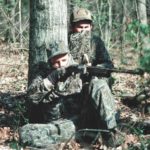
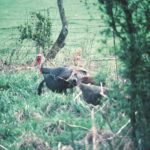
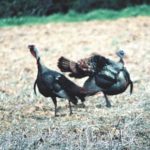
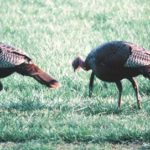
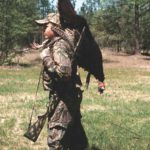
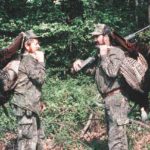



Be the first to comment